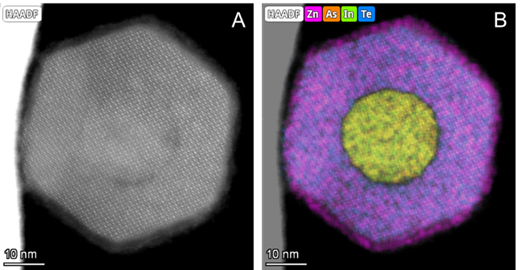Semiconductor core-shell nanowires and superconductor hybrid nanostructures
Moïra Hocevar
Univ. Grenoble Alpes, Grenoble INP, CNRS, Institut Néel, 38000 Grenoble, France
The control and the manipulation of topological superconductivity may lead in the future in the development of novel quantum bits less sensitive to decoherence than traditional qubits. Among the different strategies proposed to create topological superconductivity, one of them consists in interfacing a superconductor, typically Al, with a one-dimensional semiconductor having a large spin-orbit coupling. In devices based on this combination of materials, superconductivity emerges in the semiconductor via the proximity effect. In theory, topological superconductivity appears in those devices via symmetry breaking in the presence of a magnetic field or a magnetic material. However, a clear observation of topological superconductivity is still missing and two reasons have been advanced: (1) the devices function in the strong coupling regime in which Andreev bound states live and (2) disorder in the materials, in particular at the surface of the semiconductor, are responsible for the presence of unintentional states unrelated to topological effects.
I will present the efforts we are pursuing in Grenoble to tackle those challenges. Our research focuses on the growth and the structural characterization of nanoscale interfaces in nanowires and in planar surfaces. The nanowires grow in a molecular beam epitaxy reactor and we use X-ray diffraction and transmission electron microscopy (TEM) to evaluate and optimize the properties of our core-shell nanowires.
First, the very promising InSb/Sn system will be presented. Hybrid nanowire devices based on this system have shown excellent low temperature electronic properties, in terms of large superconducting gap and 2-e parity charging in Sn superconducting islands. [1] We studied the properties of Sn films grown at cryogenic temperatures on InSb substrates and on nanowires by X-ray diffraction. It appears that post-growth capping plays an important role for the structure of the Sn films. [2] Next, Sn crystalline phases differ when grown on planar surfaces and on nanowires under our growth conditions.
Then, I will show our first data on the growth of II-VI shells around InAs nanowires. Those shells can act as intermediate tunnel barriers between a superconductor outer shell and the core nanowire to tune the proximity effect in the semiconducting core and reach the weak coupling regime in superconductor-semiconductor nanowire devices. [3] Preliminary TEM analyses demonstrate a perfect epitaxial relationship between the II-VI semiconductor and InAs [4].
Overall, our efforts in developing hybrids nanowires have led to a constant improvement of their quality, through the careful optimization of the growth conditions and structural properties. In the future, we will correlate their low temperature transport properties with their crystalline structure and evaluate their suitability for quantum devices.

[1] M. Pendharkar, B. Zhang, H. Wu, A. Zarassi, P. Zhang, C.P. Dempsey, J.S. Lee, S.D. Harrington, G. Badawy, S. Gazibegovic, J. Jung, A.-H. Chen, M.A. Verheijen, M. Hocevar, E.P.A.M. Bakkers, C.J. Palmstrøm, S.M. Frolov. Parity-preserving and magnetic field–resilient superconductivity in InSb nanowires with Sn shells. Science, 2021, 372 (6541), pp.508-511. [link]
[2] A.-H. Chen, C.P. Dempsey, M. Pendharkar, A. Sharma, B. Zhang, S. Tan, L. Bellon, S.M. Frolov, C.J. Palmstrom, E. Bellet-Amalric, M. Hocevar. Role of a capping layer on the crystalline structure of Sn thin films grown at cryogenic temperatures on InSb substrates. 2023. Arxiv 2301.12424. [link]
[3] M. J. A. Jardine, D. Dardzinski, M. Yu, A. Purkayastha, A.-H. Chen, Y.-H. Chang, A. Engel, V. N. Strocov, M. Hocevar, C. J. Palmstrøm, S. M. Frolov, N. Marom. First Principles Assessment of CdTe as a Tunnel Barrier at the a-Sn/InSb Interface. 2023. Arxiv 2301.02879. [link]
[4] D.O. Mosiiets, S.Tan, J.Cibert, E.Bellet-Amalric, S.M.Frolov, M.Hocevar. 2-shell superconductor-semiconductors nanowires: InAs/ZnTe growth. 21 st European Workshop on Molecular Beam Epitaxy (EuroMBE 2023). Madrid, Spain. 2023.